Cats are essentially asocial. This is often miscontrued as demeaning by cat lovers (ailurophiles), or sociopathic by ailurophobes. The reason for their asocial nature relates to the hard-wiring of their brain, specifically their cerebral cortex. In order to maximise utilisation of cerebropinal reflexes essential for hunting, cats have evolved into great hunters by maximising physical skills at the expenses of social skills[1].
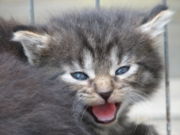
Specifically, cats lack the mirror neurone complexity [2] common to social animals such as humans and dogs. Therefore, it is physically difficult, if not impossible, for cats to comprehend the full spectrum of human emotions. Like nature herself, cats are not cruel in the way they behave, just indifferent. Cats express fear, disgust, pleasure, but not to the degree seen with humans or dogs. The oft-used metaphor is comparing them to a tone deaf person listening to Mozart. But what they lack in compassion, they more than compensate for with cunning and curiosity[3].
Although bonding does occur between a queen and her kittens (the basic feline social unit), generally speaking, cats bond loosely with other cats or humans. Consequently, they rarely suffer clinically from separation anxiety.
Behavioural problems can begin in utero. Kittens that experience extremely restricted nutrition in utero never behave normally. More often, behavioural problems are genetic (‘highly strung’ queens tend to produce ‘highly strung kittens), or develop due to extraterritorial (stray cats hanging around) or intraterritorial stressors (change of house, new cat or new household member, change of food, etc).
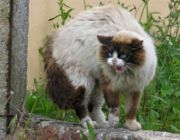
Territoriality is the leading problem with domesticated cats, causing significant stress both between cats and between cats and household owners. A cat’s sense of smell, vision and hearing are critical in most aspect of territoriality.
Because cats lack the executive pre-frontal cortex of homo sapiens, they are limited in their capacity to express stress. Usually stress is manifest as either external or internal (self) destructive behaviour. Although the exact neuroanatomic basis of these changes has not been fully elucidated, the neurophysiology of stress has been well researched and it appears that the plastic neurones of the cortex become fixed at around 6 – 7 months of age, after which, behavior becomes more or less fixed[4]. The response to fear in cats appears to be regulated by interplay between the amygdala and hippocampus[5].
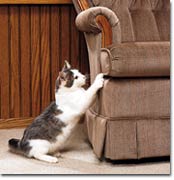
Normal behaviour
– Feline socialisation
– Feline personalities
Territorial behaviour disorders
– Aggression
– Inappropriate elimination
– Furniture scratching
Stress-induced behaviour
– Neurophysiology of stress
– Displacement activities
– Obsessive compulsive disorders

Disease-induced abnormal behaviour
– Compulsive roaming
– Senility
– Anxiety
– Depression
– Dysthymia
– Hypersensitivity-hyperactivity syndrome (HsHA)
– Overgrooming
Sexual behaviour disorders
– Hypersexuality
– Cannibalism
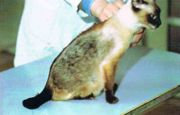
Anthropomorphic behaviour
– Feline dependent disorder
– Feline narcissism
– Feline histrionic disorder
– Feline antisocial disorder
– Feline paranoid disorder
Density of free-ranging domestic cats appears directly dependent on food resources. Most domestic cats are solitary hunters.
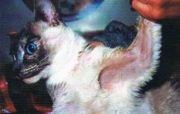
Paternity appears to be an important determinant of personality in cats. Toms that are adventurous, outgoing, and friendly appear to produce kittens of similar personality. There appear to be genetically “unfriendly,” “timid,” or “shy” cats for which no amount of handling can make a difference; the genetic mechanism for this is poorly understood. The role of early experience and exposure for kittens cannot be overemphasized.
Kittens between 2 and 7 wk of age that are handled by people are friendlier toward people and more outgoing and may have fewer problems with some forms of aggression, although the latter is poorly quantified. The effect of early handling can augment the paternal effect toward a willingness to explore. Between 12 and 14 wk of age, kittens switch from social play to social fighting and a more predatory play. Early weaning will hasten this change[6].
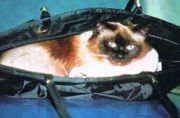
Physical diseases can contribute to changes in temperament and these should be excluded as part of a routine physical examination. Diseases which can cause significant changes to a cat’s temperament include:
- Overgrooming, due to stress, hyperesthesia syndrome, FHV, eosinophilic granuloma complex
- Urine spraying – usually indoor cats stressed by other cats roaming around the house
- Aggression – transference, threats, tenderness (pain)
- Pica – inappropriate eating (dirt, plastics, kitty litter, etc), early weaning, some breeds (Siamese, Burmese), stress
- Aloofness (wanting to be alone, but not aggressive) is usually because of illness, pain or queen ready to give birth.
- Increased friendliness often due to illness (seeking attention)
- Epilepsy – cryptococcus spp, Histoplasma spp, Lymphosarcoma and other cancers, trauma-induced, Coccidioides spp, Cytauxzoon spp
- Apathy – Worms, Haemoplasmas – Babesia spp, Anaplasma spp
- Dietary imbalance – excess protein leading to reduced serotonin/dopamine/GABA/norepinephrine levels
- Chronic renal disease – inappropriate vocalisation/ambulation (2ry uremic encephalopathy)
- Liver disease – inappropriate vocalisation (2ry hepatic encephalopathy)
References
↑ Stecina K & Jankowska, E (2007) Uncrossed actions of feline corticospinal tract neurones on hindlimb motoneurones evoked via ipsilaterally descending pathways J Physiol 580(1):119–132
↑ http://en.wikipedia.org/wiki/Mirror_neuron
↑ Dodman, NH (2009) Feline sense, social structure and aggression. Pers comm.
↑ Merck Vet Manual
↑ Collins DR (2009) Differential modulation of hippocampal plasticity in a non-noxious conflict model for anxiety. Neuroscience 162(4):863-869
↑ Dodman, NH (2009) Feline sense, social structure and aggression. Pers comm.